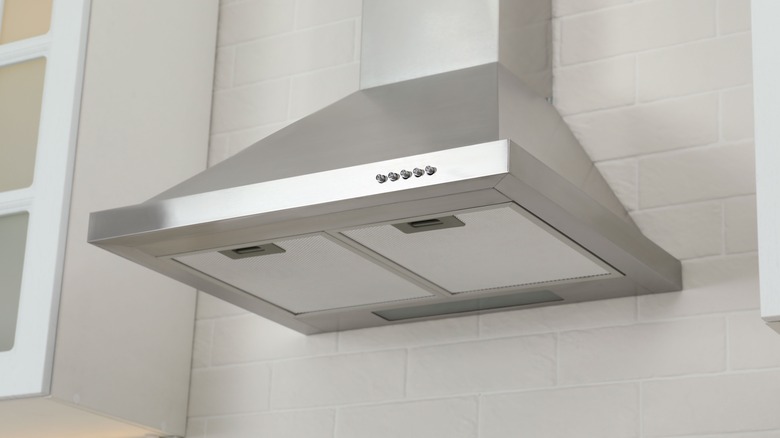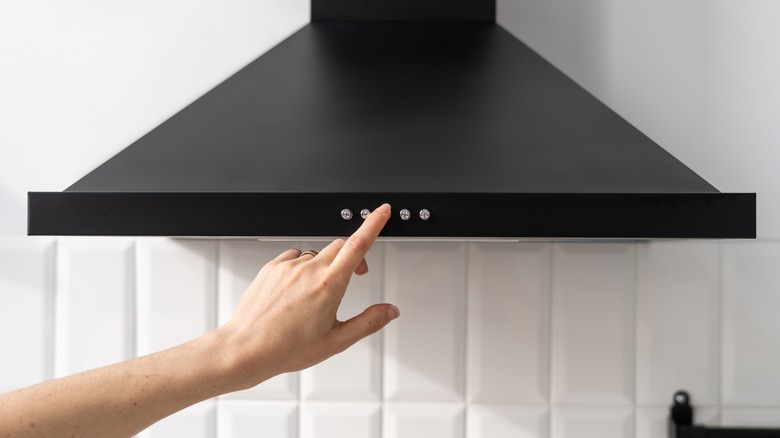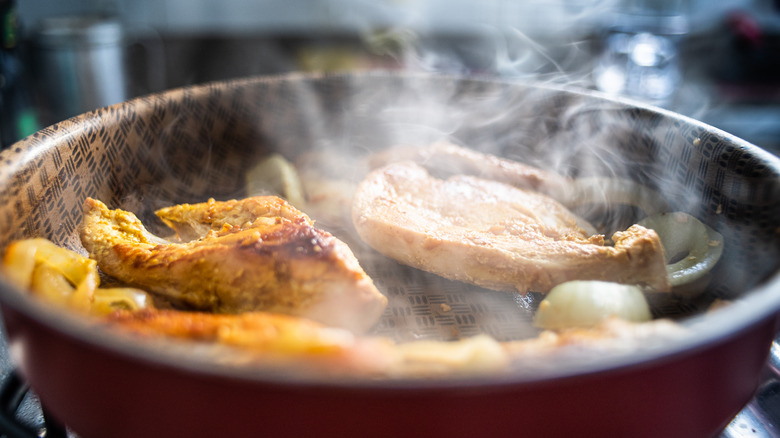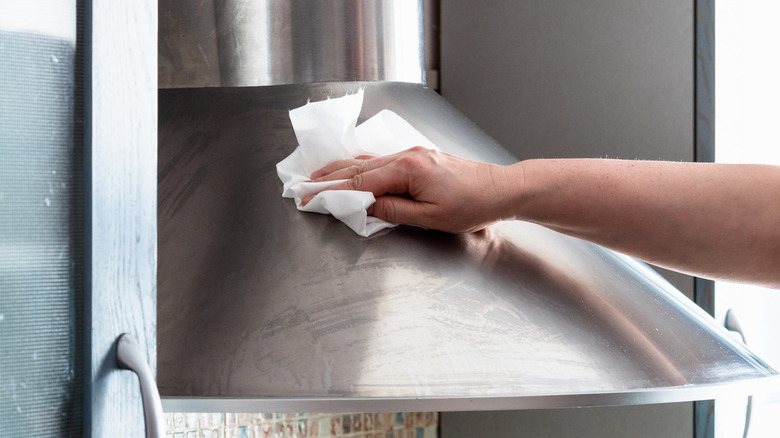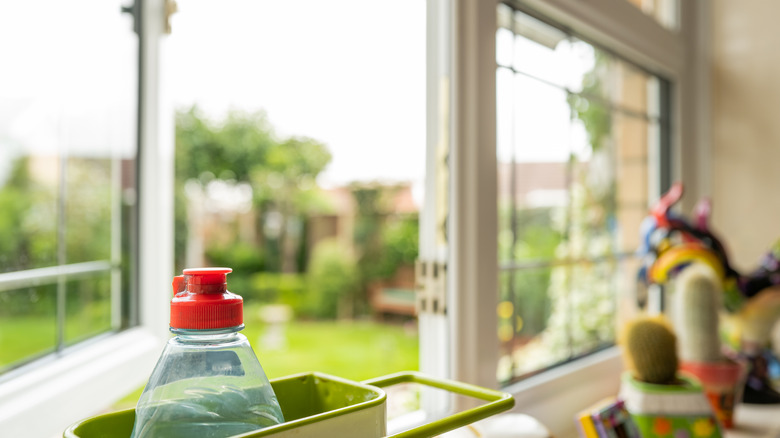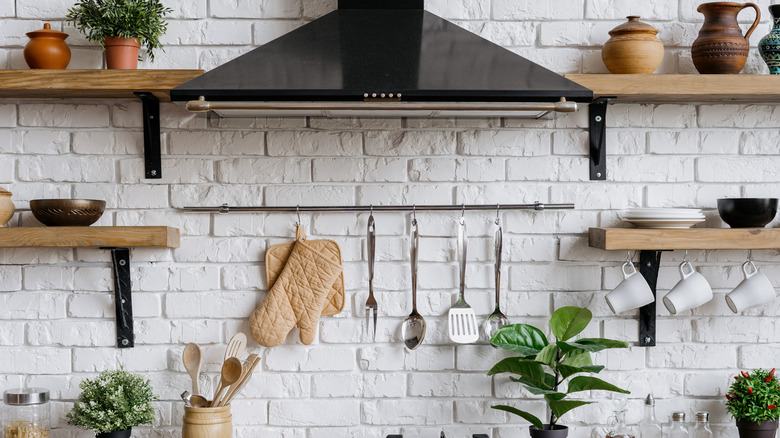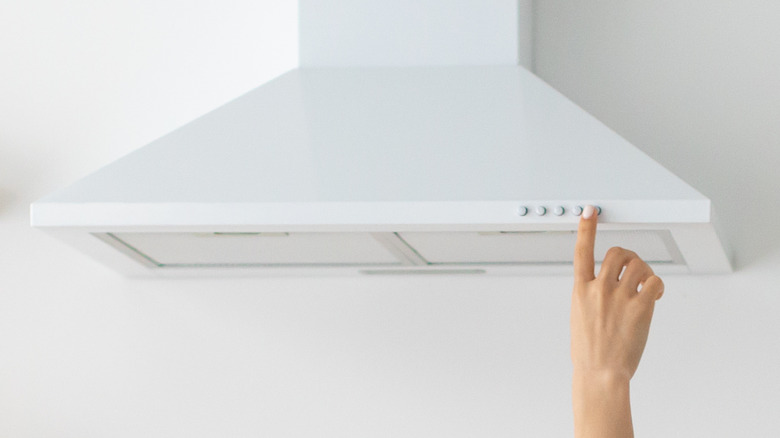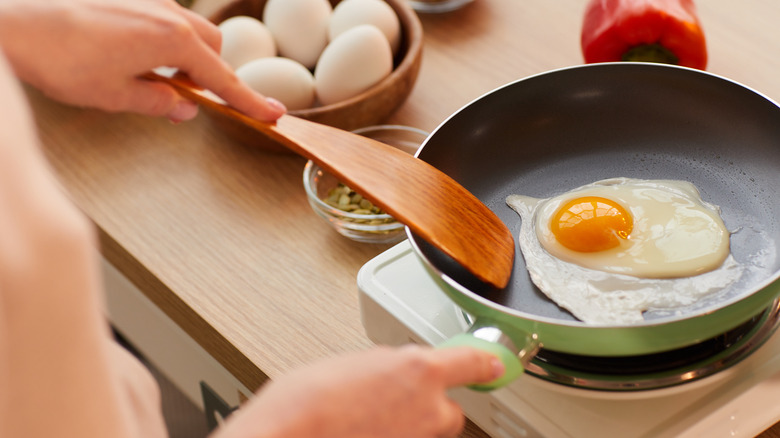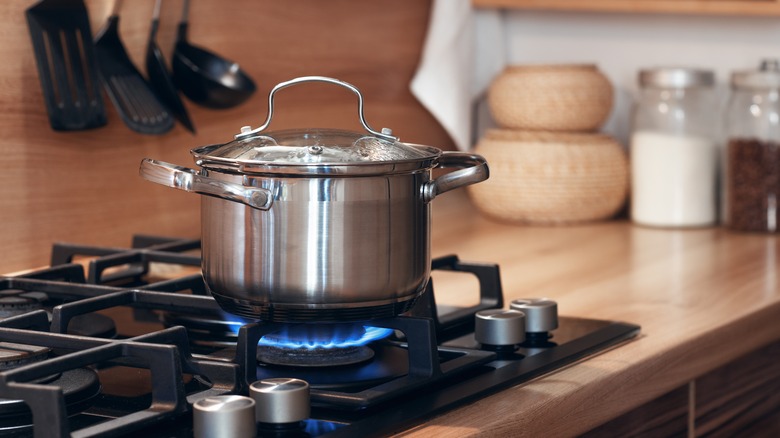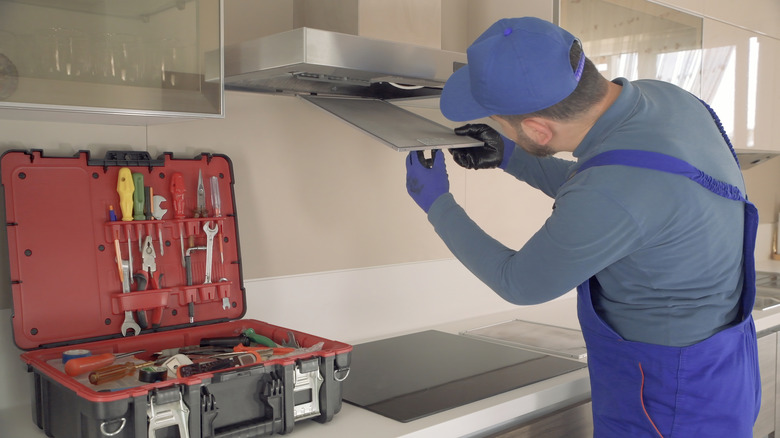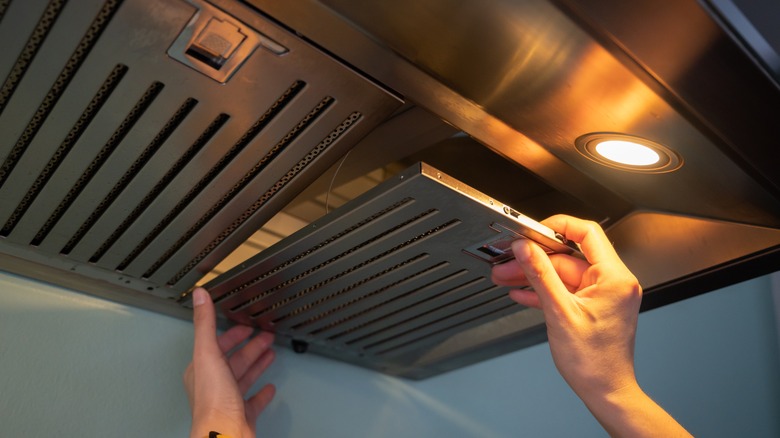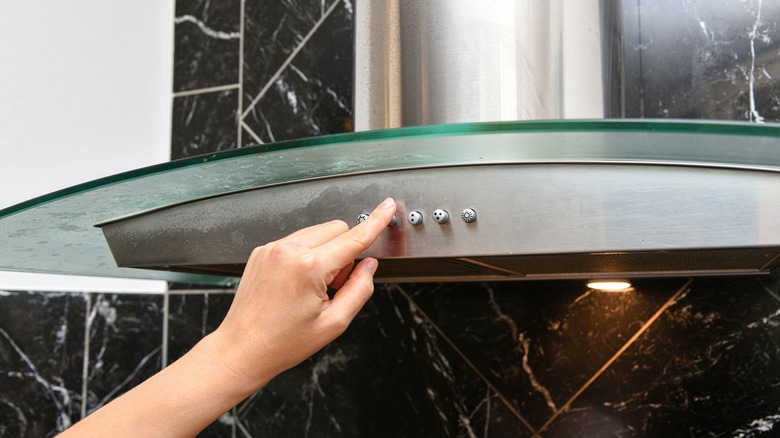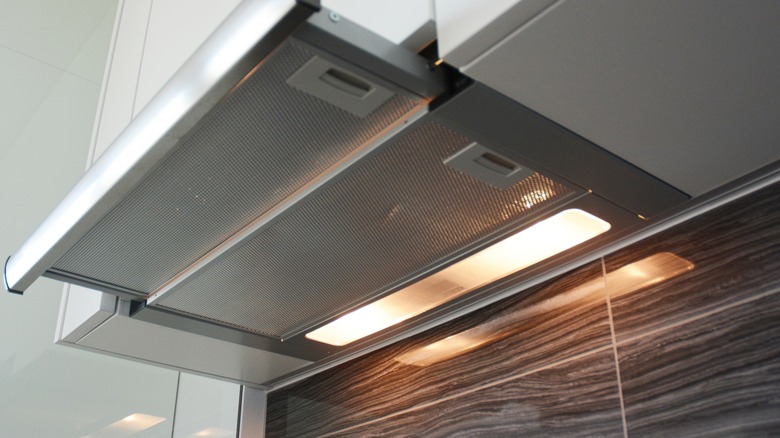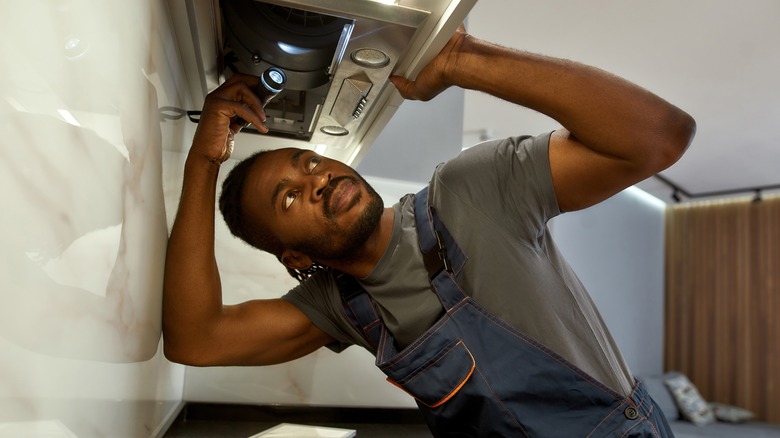13 Mistakes Everyone Makes When Using Their Range Hood
Your range hood is the unsung hero of your kitchen. They may not be glamorous or flashy, but range hoods perform a vital function when you're cooking food, namely pulling air containing smoke, grease, and humidity out of the atmosphere above and around your pan. The hood then either filters the air, removing the impurities, before returning it into your kitchen, or it kicks the air out of your home entirely through a system of ducts. Doing this serves several vital functions: Not only does it make your kitchen's air nicer to breathe, smell better, and improve its overall quality, but it also helps to prevent moisture and grease buildup.
Sounds simple, right? Unfortunately not. Range hoods may seem as easy to use as flipping on a switch, but simple errors like turning them on too late can make them largely ineffective. Failing to maintain them properly can also cause range hoods to become useless over time, and forgetting about some key features can make your cooking and cleaning experiences much trickier. Let's get under the hood of these appliances so that you're using them to their full potential.
1. Turning your range hood on halfway through cooking
Be honest: How many times have you forgotten to flick on your range hood until your kitchen's already full of smoke? We all go there from time to time — but we really shouldn't. If you fail to turn on your range hood before you start cooking, you miss the opportunity to catch smoke, grease, and moisture (as well as nasty food smells) from the start. Those pollutants can then disperse throughout your kitchen and move out of the range of your hood's suction power, and you have to rely on some other method to get rid of them.
Instead, you should always turn on your range hood a few minutes before you start cooking. This will ensure that you won't miss anything and that by the time your smoke starts wafting from your pan, your range hood will be ready to suck it up. Turning it on before you start cooking is also a great move for older range hoods, which might take a little time to fire up to full power. While it can be easy to forget to do this, try to make a habit of not allowing yourself to turn your heat on before your range hood is going.
2. Only using it for smoky food
For some people, the range hood is a piece of equipment that only gets fired up when they're searing or charring certain foods. However, sucking up smoke is not the only thing they're good for. While smoke is of course the most visible substance that gets handled by range hoods, they also deal with food odors, grease, and water vapor released by your food.
Remember that smoke isn't the only thing that can cause irritation to you or damage to your kitchen. Water vapor can lead to a buildup in humidity, which can degrade your fixtures and furnishings, ruin your paintwork or brickwork, and contribute to mold growth. Grease, meanwhile, can build up invisibly on your cupboards and cooking surfaces, giving them nasty smells and making them a nightmare to clean. Food odors can also get into soft furnishings around your house and fabric-based items like kitchen curtains and ruin your home's ambiance. A good rule of thumb, therefore, is to use your range hood every time you're cooking food, even if you're doing something as simple as boiling an egg or a pot of pasta.
3. Forgetting to clean its exterior regularly
Like all things in your kitchen, your range hood should be cleaned at regular intervals — but it's not just the interior you should be tackling. Your range hood's entire exterior, consisting of its canopy, control panel, duct cover, lamps, and the outside of its grease filter, should all be cleaned thoroughly. These parts are all prone to grease buildup, which can contribute to a poor smell and appearance. Grease can also stop certain parts from working correctly, like the control panel and your lamps, which may be dulled by excessive buildup.
When dust settles on this grease, things can get even worse and more difficult to clean. As such, it's time to roll up your sleeves. Set aside time regularly to thoroughly clean the outside of your range hood using a solution of warm water and anti-grease dish soap. Make sure you use a soft cloth so that you don't end up scratching its surface. You should then do the same on its underside, wiping away any grease around the lights and using a smaller brush or cotton swab to get into the grooves around the control panel. If any grease remains after your first clean, repeat the process, finishing things off by giving everything a wipe with a dry, soft cloth.
4. Only using your hood without opening your windows
If your kitchen has windows, you shouldn't just be relying on your range hood to filter out smoke and grease. Opening your windows can give these pollutants somewhere else to go and helps significantly to clear your kitchen of bad smells. This is doubly important to do if your range hood isn't linked up to an external duct. "If you have a range hood that just recirculates air back into the kitchen, you need to use another exhaust fan — for example, from a nearby bathroom — or open windows," air quality investigator and scientist Brett Singer tells Stanford University. Doing this can improve the overall air quality of your kitchen and your home.
If you have windows in two different locations in your kitchen, opening them both can create a through-breeze that can whip moisture, smoke, and smells away. If you don't, try opening a window elsewhere in your home, as well as in your kitchen. While it can be tricky to remove moisture if you don't have windows in your kitchen, using a portable dehumidifier in tandem with your range hood can help considerably. By far the most useful tool in your arsenal is your range hood, though, so make sure you're switching it on.
5. Using a poorly mounted range hood
Range hoods are usually mounted by trained professionals, but even professionals get it wrong now and again. If your range hood was mounted at the wrong height, either too high or too low, using it while cooking might pose some issues. Range hoods that are mounted too low have to work harder to suck up all of the grease, smoke, and moisture, as it hasn't diffused enough when it reaches the filters. This can cause them to deteriorate faster and potentially stop working sooner than you'd like. Range hoods that are too low can also make cooking trickier, and for gas stoves, they could pose a fire hazard when used.
Using a range hood that's mounted too high, however, will mean that you're wasting valuable energy on something pretty ineffective. When your hood is too high, it just won't be able to extract as many pollutants as it should, as by the time they've reached the fans, they'll also have largely dispersed into your kitchen's atmosphere.
The solution isn't to simply not use your range hood in either of these situations, though. You should instead have it remounted immediately. Most range hoods should be somewhere between 24 to 32 inches away from your stovetop, although they can be lowered to 20 inches with electric cooktops.
6. Always running your range hood at maximum speed
There's something comforting about flicking a range hood to its top setting and hearing the roar of the fan, safe in the knowledge that all your smoke and moisture will be removed from your kitchen. However, it's rarely a wise thing to do. Your range hood's maximum speed should only really be used for intense cooking with brief high heat or large amounts of smoke. Most of the time, a lower setting should be entirely sufficient to get rid of air pollutants.
This is particularly true if you're cooking for long periods: Picking the highest speed will just overwork the fan. This will, inevitably, lead to you having a higher energy bill. Using the top setting excessively will also leave you at more risk of deteriorating your appliance and shortening its lifespan, or leading to you having to get replacement parts quicker than you'd anticipated. Remember, too, that opening your kitchen windows will help your range hood out to no end, removing moisture and food smells and bringing some wonderful fresh air into your home — for free.
7. Assuming you only need it when frying food
If you're making a slow-cooked stew or ragu or gently boiling rice, putting on a range hood can seem pointless. After all, barely any grease or smoke is being created, so you might as well save it for your pan-fried eggs, right? Well, remember that food isn't the only thing that releases air quality-affecting substances. If you're cooking with a gas stove, you're faced with a steady stream of nitrogen dioxide being released into your kitchen, as well as other tiny, irritating airborne particulates. Nitrogen dioxide has been observed to prompt asthma symptoms and may increase the likelihood of developing asthma in children.
Using your range hood when cooking anything on a gas stove, therefore, is pretty helpful. While all range hoods may not remove these pollutants entirely, those that extract air to the outside of your home are most helpful. You can also mitigate nitrogen dioxide and particulate buildup by keeping windows open when you cook. If you're particularly concerned about your kitchen's air quality, though, it may be a good idea to switch to an electric cooktop.
8. Only using the front burners
Prioritizing the front burners on your cooktop makes perfect sense. After all, they're the closest ones to you, and why would you reach for the back if you didn't have to? Well, because your kitchen's air quality will thank you for it. Your back burners are far more covered by your range hood when compared to your front burners, from which smoke and grease can escape into your kitchen more readily. "The airborne compounds and chemicals tend to rise up in a column over the pan or pot you're using and so you can imagine, that if it's completely covered by the vent sucking out the air, you're capturing a lot more of the airborne pollutants," notes "The Great Outdoors" author and science journalist Emily Anthes to The Kitchn.
Anthes' claims are backed up by a study on the very subject published in Environmental Science & Technology. Researchers found that when the back burners were used, range hoods were way more efficient at capturing pollutants. This not only means that cooking on the front burners releases more pollutants into the air, but it also means that you're not using your range hood to its full potential and possibly just wasting electricity. That's not to say you shouldn't use your front burners at all, of course. Just try to keep a window open while doing so.
9. Failing to perform maintenance checks
All kitchen appliances need maintenance checks periodically, and range hoods aren't an exception to this rule. Failing to do so can leave you missing something that might ruin your machine. Removing the hood interior and checking inside for grease, assessing the condition of your filter, and peeking inside your air ducts for buildup or damage can all help to keep your range hood in good working order and tackle potential failures before they occur.
One of the main things you need to watch out for when performing a maintenance check is built-up dirt or grease. If left uncleaned, these can block your ducts or limit the efficacy of your filters, preventing smoke or grease from being properly removed. While you shouldn't be afraid to poke around inside your range hood (steering well clear of any wiring, of course) and keep it spick and span, it can also be a good idea to book a periodic check from a professional. A yearly or semiyearly inspection can allow an expert to see when certain parts might need replacing and prevent an unexpected breakdown.
10. Forgetting to clean or replace your filters
If your filters are unclean or blocked, it's pretty much pointless turning your range hood on. The filters, as their name suggests, sift out any contaminants in your kitchen's air and work to remove grease, smoke, and moisture from your atmosphere. However, because they spend all their time combating pollutants, they can get clogged up or deteriorate quite quickly, rendering them useless.
The first step to maintaining your filters is identifying what type you have. Filters are generally made from metal or charcoal, with metal filters coming on ducted models and charcoal ones fitted on ductless range hoods. If you have a metal filter, it's best to clean it monthly to remove any built-up grime and replace it if it becomes inoperable or damaged. Charcoal filters, on the other hand, should be fully replaced every six months or so, as they lose their efficacy over time.
Some filters are also fitted over grease trays, which collect filtered-out grease and which need to be cleaned or replaced periodically. As all range hood designs are slightly different, it's best to refer to your manufacturer's instructions to ensure that you're performing these procedures safely.
11. Turning the hood off at the wrong time
A lot of the time, range hoods are pretty noisy beasts, so it's understandable that you want to turn that fan off while you kick back with your dinner and your favorite TV show. However, don't be too hasty to flick it off after cooking. There will likely still be pollutants in your kitchen's atmosphere that need sucking up, even once you've turned your stove off, and failing to keep your range hood running will make the air quality in your kitchen worse.
It's best to keep your range hood running for around 15 minutes after you've finished cooking. This is doubly important to do if you have pans on the stove with leftover food in them, which might still be releasing steam or grease into the air, albeit in smaller quantities. If it's been in a high setting, make sure to turn it down, both to limit noise and to stop the fan from becoming worn out. You should also remember to keep open any windows you've cracked while you've been cooking, to keep fresh air circulating as your kitchen clears.
12. Forgetting to turn on the light
That light embedded in your range hood is way more useful than you think — yet a lot of people fail to use it at all and rely on the lighting in their kitchen while they're cooking. Do this, though, and you're more likely to ruin your food. Your range hood lamps illuminate your food with greater intensity than your overhead lights, and this lets you see when items you're sautéing or frying have developed the right color. It also lets you see where any splatter or mess has gone while you're cooking, letting you clean it up easily before it sets in.
There's also an aesthetic purpose to your range hood lamps, and they can offer another source of light in your kitchen without you having to rely on harsh overhead bulbs the whole time. Make sure you're keeping your range hood lights clean, wiping them down to remove any grime or dust frequently. Bulbs should be replaced roughly every 6 to 12 months, but you might find you need to swap them out sooner if you're using cheaper bulbs. Range hood lights are also prone to blowing from becoming overheated, so keeping your kitchen ventilated to remove excess heat while cooking is always a good idea.
13. Ignoring a noisy fan
Most range hoods make some noise, but if you notice that yours is a bit louder than usual, it's time to pay attention. Suddenly noisy fans can indicate a maintenance issue in your machine that needs addressing. It might be the case that your non-return valve (the part of the range hood that stops dirty air from recirculating into your kitchen) has loosened, or your range hood's motor casing has broken, which allows it to rattle around more freely. Noisiness can also indicate that your fan's motor has started to rust or is clogged up with dirt and needs replacing, or that the filter has broken or become worn out.
Any of these issues need attention, as ignoring them will just make things louder and more disruptive before your fan breaks altogether. If your fan has become louder, the best thing to do is schedule a service. It's always better to have a trained professional diagnose and fix the problem, instead of poking around in your machine's interior and risking damaging it, or yourself. If, however, you're certain that the issue is easily fixed, like a clogged-up charcoal filter that needs replacing, you might be able to tackle it yourself.
